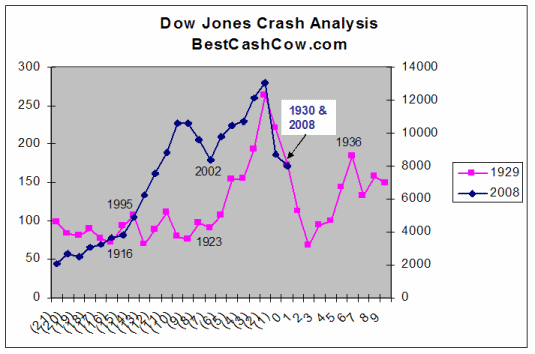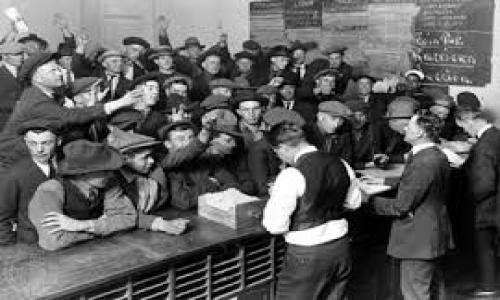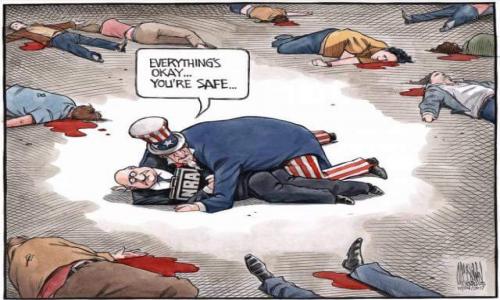Today, as I watched the Dow sink below 8,000, I wondered how the sell-off of the last six months compares to the sell-off during the Great Depression. The chart below shows what I found. To create it, I graphed historical data taken from the DJ Indexes website for the Dow Jones Industrial Average.

Let me explain how to read the chart.
The years 1930 and 2008 are time 0 on the x axis of the graph. I then looked at the 21 years before 1930 and 2008 to see how the markets performed before the 1930 and 2008 crashes. I also charted the 10 years after the crash in 1930, represented by the positive numbers on the X axis. The left Y axis shows the Dow's price during the early part of the 20th century and the right Y axis shows the Dow's price in more modern times. One other note on the methodology is that I used the closing price of the Dow on November 11 of each year.
As you can see by looking at the blue and pink lines, before both crashes there was a sharp run-up in the value of the Dow. But the data shows that the pre-crash bubble is much bigger now than it was prior to the Great Depression. While the Dow increased about 2.5x during the priod 21 years before the crash of 1929-1930, it increased over 6X from 1988 to 2008.
In 1929, with Black Friday, the Dow began to deflate and it hit a bottom in 1932. By that point, the Dow was down almost 75% from its peak a few years earlier. Today, the Dow has fallen about 42% from its high of 13,850. As the chart shows, if this economic downturn is not over and comes close to approaching the early severity of the Great Depression, then the Dow is not done falling. It's important to note that the largest damange to the market happened at the beginning of the Depression. While economic problems continue until the beginning of World War II, the stock market began to recover from its lows in 1936. What does that mean? It means that even if our current downturn doesn't last as long as the Depression, it could be as deep for a concentrated period of time, and during that time cause further equity losses.
I don't usually use Wikipedia as a source but I came across this entry on the Great Depression and thought it appropriate. You can decide if there are parallels to today:
The Great Depression was not a sudden total collapse. The stock market turned upward in early 1930, returning to early 1929 levels by April, though still almost 30 percent below the peak of September 1929.[6] Together, government and business actually spent more in the first half of 1930 than in the corresponding period of the previous year. But consumers, many of whom had suffered severe losses in the stock market the previous year, cut back their expenditures by ten percent, and a severe drought ravaged the agricultural heartland of the USA beginning in the northern summer of 1930.
In early 1930, credit was ample and available at low rates, but people were reluctant to add new debt by borrowing. By May 1930, auto sales had declined to below the levels of 1928. Prices in general began to decline, but wages held steady in 1930, then began to drop in 1931. Conditions were worst in farming areas, where commodity prices plunged, and in mining and logging areas, where unemployment was high and there were few other jobs. The decline in the American economy was the factor that pulled down most other countries at first, then internal weaknesses or strengths in each country made conditions worse or better. Frantic attempts to shore up the economies of individual nations through protectionist policies, such as the 1930 U.S. Smoot-Hawley Tariff Act and retaliatory tariffs in other countries, exacerbated the collapse in global trade. By late in 1930, a steady decline set in which reached bottom by March 1933.
The quote doesn't touch on the obvious parallels in the banking system. Although there haven't been as many bank failures, the magnitude of the financial failures today are enormous - Bear, Lehman, Fannie, Freddie, Wachovia, Washington Mutual, Countrywide, National Citi, AIG. I realize not all of these were failures but many of the banks listed were purchased at firesale prices to prevent a failure.
The question to ask yourself about this recession is whether you think it's like the relatively mild downturns of 2001-2002, and 1991-1992 and even 1980 or is it really the worst economic downturn since the Great Depression? Because if you believe the latter, then that blue line has further to fall.
For an update on this article from August 3, 2011, click here.













Comments
Barry Baker
November 21, 2008
Very insightful analysis and a good provision of context for the worst case scenario. The author is obviously brilliant and on-point. I have a request...can you research the comparable volatility of the Dow during the same periods?? Does the author think we are going into the Great Depression II?
Keep up the great work!
Is this review helpful? Yes:0 / No: 0
Sam Cass
November 22, 2008
Here's an interesting article comparing today to the Depression. I'm not as optimistic as the author but I also don't think things will be as bad the Depression.
http://www.kiplinger.com/features/archives/2008/11/depression_not_coming.html
Is this review helpful? Yes:0 / No: 0
Chuckoo
November 25, 2008
Nice chart! I wonder how do you scale the two Y axes. As they are drastically different price range for the two periods. Depending on how you scale it, the downward slide that we are supposingly in as the chart suggests, may have a lot more to go or that we are already done. Thanks.
Is this review helpful? Yes:0 / No: 0
Mungdavu
January 09, 2009
Who really knows what is going to happen......all the charts, numbers, and/or data is never going to be able to predict the future. I suggest everyone to take a listen to some REO Speedwagon and "Ride the Storm Out", because that is about all we can do at this point...... Keep Pushin' is what I say....
Is this review helpful? Yes:0 / No: 0
Pam
January 10, 2009
Thank you!
Is this review helpful? Yes:0 / No: 0
Karl
January 15, 2009
If that is to happen, and it quite possibly will, the next drop or boom will happen in the next couple weeks. I am personally betting on an Obama rally, but am preparing to exit the market if the S&P 500 drops below the level hit at the end of the last cycle.
Is this review helpful? Yes:0 / No: 0
Anette
January 21, 2009
Financials are melting down this week. Roubini says finacial system is insolvent. I think we have further down to go.
Is this review helpful? Yes:0 / No: 0
William A.
January 26, 2009
I too believe the blue line has a long way to fall yet. I'm afraid that with the new stimulus package and the abysmal failure of the first, the commercial tsunami on the way and all the political bickering we will see a 5 or 6000 on the DOW before the end of 2009. God help us, I hope I am wrong.
Is this review helpful? Yes:0 / No: 0
ellsfran@aol.com
January 29, 2009
If I had my way, we'd stimulate the economy by lowering individual's tax rates rather than issuing stimulus checks.In that way the economy would be stimulated each payday with people spending the extra money rather than saving it or paying off debts.Second,banks are afraid of toxic mortgages on the other bank's balance sheet. therefore, instead of just giving them money, guarantee their loans to one another otherwise they'll just use the bailout money to finance their cost of doing business and won't have to loan out money to stay in business, thus prolonging the credit crunch.
Is this review helpful? Yes:0 / No: 0
Bubba
February 23, 2009
What about the price difference between then and now, I think that would indicate we are in the Great Depression II, because today we sure cannot go out and buy a loaf of bread for $0.05, or see a movie for $0.25 or even buy a new car for the price it was back then. Do these people not even realize this... Or are they just not bringing it up to keep peace in America.
Is this review helpful? Yes:0 / No: 0
Add your Comment
use your Google account
or use your BestCashCow account